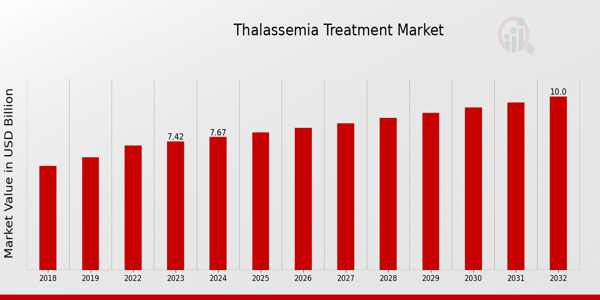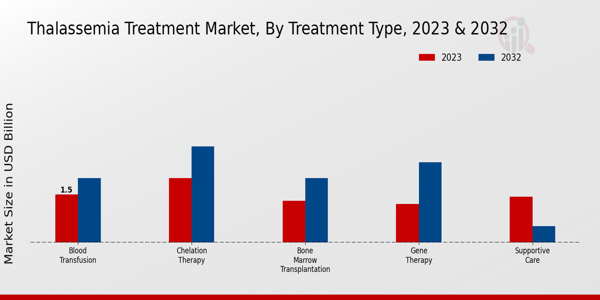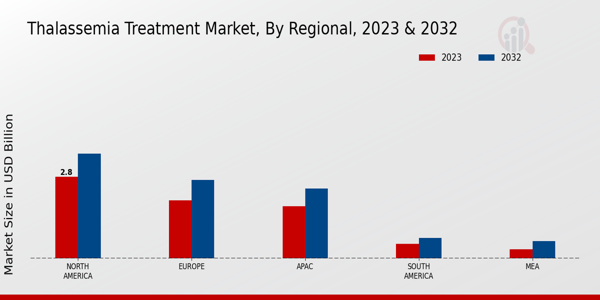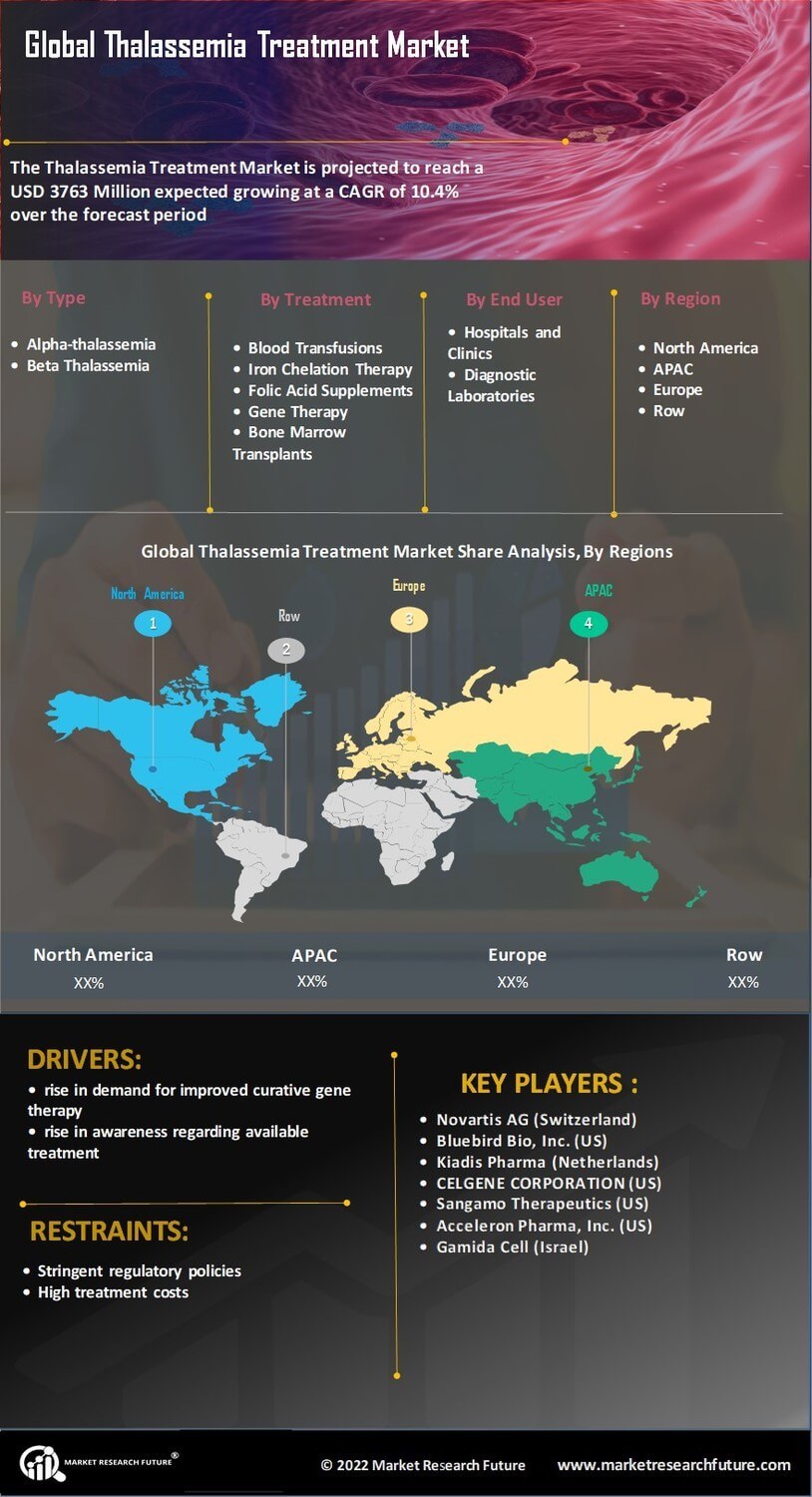Thalassemia Treatment Market Overview:
As per MRFR analysis, the Thalassemia Treatment Market Size was estimated at 7.18 (USD Billion) in 2022.The Thalassemia Treatment Market Industry is expected to grow from 7.42 (USD Billion) in 2023 to 10.0 (USD Billion) by 2032. The Thalassemia Treatment Market CAGR (growth rate) is expected to be around 3.37% during the forecast period (2024 - 2032).
Key Thalassemia Treatment Market Trends Highlighted
The Global Thalassemia Treatment Market is witnessing significant growth due to several key drivers. The increasing prevalence of thalassemia, particularly in regions where it is endemic, is pushing healthcare systems to prioritize effective treatments. Advances in gene therapy and other innovative treatment options are also contributing to market expansion. Additionally, patient awareness and support from non-governmental organizations are boosting the demand for established therapies and leading to better patient compliance with treatment regimens. Efforts to broaden screening programs are likely to further increase diagnosis rates and, consequently, the demand for treatment options.
Quite a number of opportunities remain competitive in this market. For instance, the invention of new therapies such as gene editing or personalized medicine allows pharmaceutical companies to meet some of the unmet needs. Biotech companies could partner with research organizations that are able to generate new known or unknown technologies that will improve the quality of care and potentially lower the cost. There is room for expansion in developing economies where some basic and advanced healthcare services are being rolled out, which increases the chances of patients getting high-end therapies. Persistent efforts to educate the high-risk groups will enable them to seek care sooner and start treatment earlier
Recent trends indicate a shift towards personalized approaches in thalassemia treatment, moving away from one-size-fits-all therapies. The focus is on tailored treatments that consider individual genetic profiles, leading to potentially better outcomes. Additionally, patient-centric approaches are gaining ground, with an emphasis on improving the quality of life for patients through holistic care. The integration of digital health solutions is also a notable trend, helping patients manage their conditions with better follow-ups and support. The future of the thalassemia treatment landscape looks promising, with innovations and increased support systems paving the way for enhanced patient care.

Source: Primary Research, Secondary Research, MRFR Database and Analyst Review
Thalassemia Treatment Market Drivers
Increasing Prevalence of Thalassemia Disorders
The growing global prevalence of thalassemia disorders is a major driving force behind the expansion of the Global Thalassemia Treatment Market Industry. Thalassemia, which is an inherited blood disorder characterized by reduced hemoglobin production, affects millions of individuals worldwide. Each year, an increasing number of people are diagnosed with thalassemia, prompting the need for effective treatment solutions. This rise in cases is primarily attributed to higher rates of consanguineous marriages in certain regions, genetic factors, and a lack of awareness regarding preventive measures.
As public awareness increases and genetic counseling becomes more prevalent, early diagnosis and treatment options are becoming more accessible. This trend leads to a surge in demand for thalassemia treatment, including therapies such as blood transfusions, iron chelation therapies, and stem cell transplants. Moreover, advancements in gene therapy and targeted treatments, aligned with ongoing research initiatives, are expected to enhance the quality of life for patients living with thalassemia.
As a result, healthcare providers and pharmaceutical companies are intensifying their efforts to address the growing patient population, thus contributing significantly to the growth of the Global Thalassemia Treatment Market and ensuring that innovative treatment options are made readily available.
Advancements in Treatment Technology
The continual advancements in treatment technology act as a crucial driver for the growth of the Global Thalassemia Treatment Market Industry. Innovative approaches such as gene therapy, which aims to correct the underlying genetic defects causing thalassemia, are revolutionizing treatment methodologies. Additionally, improvements in blood transfusion techniques and iron chelation therapies are enhancing patient outcomes by reducing complications and side effects associated with traditional treatment methods.
The focus on personalized medicine and the use of targeted therapies tailored to individual patient needs further exemplify the industry's commitment to advancing treatment options. Consequently, the market is witnessing a significant increase in research and development activities, resulting in a burgeoning pipeline of novel therapies that cater to the diverse requirements of thalassemia patients.
Supportive Government Policies and Initiatives
Supportive government policies and initiatives play a pivotal role in accelerating the growth of the Global Thalassemia Treatment Market Industry. Many countries are recognizing thalassemia as a critical public health issue and are implementing frameworks to enhance diagnosis, prevention, and treatment. National screening programs, awareness campaigns, and funding for research projects are being established to address the challenges posed by thalassemia.
This increasing governmental support not only bolsters healthcare infrastructures but also incentivizes pharmaceutical companies to invest in the development of innovative therapies. By fostering collaboration among stakeholders, including patients, healthcare providers, and researchers, these initiatives aim to improve patient access to effective treatments and ensure the sustained growth of the thalassemia treatment market
Thalassemia Treatment Market Segment Insights
Thalassemia Treatment Market Treatment Type Insight
The Global Thalassemia Treatment Market is differentiated by various treatment types, reflecting a diverse approach to managing this hereditary blood disorder. In 2023, the market's Treatment Type segment showcases substantial valuations across various therapies, highlighting a growing need for effective management strategies. Blood Transfusion, a critical treatment for thalassemia patients, generated significant revenue of 1.5 USD Billion, expected to rise to 2.0 USD Billion by 2032, indicating its importance in sustaining patient health. Similarly, Chelation Therapy commands a prominent share, valued at 2.0 USD Billion in 2023, with projections of up to 3.0 USD Billion in 2032.
Its role in removing excess iron in patients receiving regular blood transfusions underscores its integral position in thalassemia treatment. Bone Marrow Transplantation represents another vital component, with a valuation of 1.3 USD Billion in 2023, anticipated to increase to 2.0 USD Billion by 2032. This therapeutic option, often considered a potential cure, plays a significant role in long-term management for individuals eligible for the procedure. Gene Therapy emerges as an innovative approach, valued at 1.2 USD Billion in 2023 and expected to grow to 2.5 USD Billion by 2032.
Its advancement offers promising potential for a more permanent solution to thalassemia by addressing the underlying genetic causes of the disorder. Meanwhile, Supportive Care stands at a valuation of 1.42 USD Billion in 2023 but is projected to decline to 0.5 USD Billion by 2032, indicating a shift in focus towards more curative options as technologies and treatments evolve. The diverse landscape of treatment types within the Global Thalassemia Treatment Market reflects both the challenges patients face in management and the opportunities for innovation and improvement in care delivery.
As such, understanding the Global Thalassemia Treatment Market data and statistics within the context of these treatment types is crucial for stakeholders aiming to make impactful strides in this sector. Market growth in this space is driven by ongoing research, advancements in gene therapies, and the increasing incidence of thalassemia globally, presenting both challenges and opportunities for healthcare systems and pharmaceutical companies involved in the Global Thalassemia Treatment Market industry

Source: Primary Research, Secondary Research, MRFR Database and Analyst Review
Thalassemia Treatment Market Route of Administration Insights
The Route of Administration segment within the Global Thalassemia Treatment Market plays a crucial role in defining treatment outcomes and patient adherence. In 2023, the Global Thalassemia Treatment Market revenue was valued at USD 7.42 billion, showcasing strong interest and investment in treatment modalities. The growth of this market can be attributed to the increasing prevalence of thalassemia and the development of more effective therapies. Among the various routes of administration, intravenous methods significantly dominate the market, largely because of their ability to deliver medications directly into the bloodstream, ensuring faster therapeutic effects.
Oral administration, while being less invasive, offers convenience for patients, making it a popular choice for maintaining treatment compliance. Subcutaneous administration also presents a noteworthy alternative, facilitating easier self-administration by patients, which can contribute to improved quality of life. Overall, the Global Thalassemia Treatment Market data highlights a diverse range of options, with each method serving distinct patient needs, ultimately driving the market growth. The Global Thalassemia Treatment Market statistics indicate a strong potential for further expansion as innovations in drug delivery continue to emerge.
Thalassemia Treatment Market Patient Age Group Insights
The Global Thalassemia Treatment Market is expected to see significant growth, particularly within the Patient Age Group sector, reflecting the diverse needs of different age demographics. The market was valued at approximately 7.42 USD Billion in 2023 and is anticipated to grow steadily. Within the Patient Age Group, the Pediatric segment remains critical as children diagnosed with thalassemia require early intervention strategies to manage the disease effectively. This age group often influences treatment decisions due to the long-term health implications associated with thalassemia.
The Adult segment also commands a significant share, as many individuals continue to seek treatment for chronic issues related to the condition, highlighting ongoing healthcare needs. Lastly, the Geriatric population, which is increasingly facing complications due to age-related factors, presents unique challenges and opportunities for tailored treatment approaches. The importance of understanding these different groups is crucial for effective market strategies and the development of targeted therapies in the Global Thalassemia Treatment Market, as diverse treatment methodologies will be required to address the unique challenges faced by each demographic, creating a comprehensive approach to thalassemia management.
Thalassemia Treatment Market Therapeutic Area Insights
The Global Thalassemia Treatment Market, valued at 7.42 USD Billion in 2023, has shown promising growth prospects within the Therapeutic Area segment. This segment is robustly structured, primarily encompassing fields like Hematology, Oncology, and Immunology. Hematology remains a pivotal part due to its focused approach on blood disorders, making it essential in managing Thalassemia. Oncology plays a crucial role as well, particularly in addressing treatment-resistant cases and combining therapies for improved outcomes. Immunology also contributes significantly, given the potential for immune-modulating treatments to enhance patient care.
The market's continuous evolution is driven by advancements in treatment options and increased awareness, which propel the Global Thalassemia Treatment Market revenue. Market dynamics, such as innovative therapies and research funding, are shaping the landscape, presenting both challenges and opportunities. However, the prevalence of Thalassemia and the need for effective treatments underscore the importance of these therapeutic areas.
Thalassemia Treatment Market Regional Insights
The Global Thalassemia Treatment Market revenue showcases a diverse landscape across various regions, with North America leading the market at a valuation of 2.8 USD Billion in 2023, expected to rise to 3.6 USD Billion by 2032. This region's dominance can be attributed to advanced healthcare infrastructure and increased awareness about thalassemia treatment options. Europe follows, with a valuation of 2.0 USD Billion in 2023, growing to 2.7 USD Billion, highlighting its significant share due to well-established medical frameworks and research initiatives.
The APAC region, valued at 1.8 USD Billion in 2023 and anticipated to reach 2.4 USD Billion, represents an emerging market driven by rising patient populations and improving healthcare access, marking it as a vital growth prospect. South America, although smaller at 0.5 USD Billion in 2023, and 0.7 USD Billion in 2032, is gradually recognizing thalassemia treatment importance, indicating potential market growth. The MEA region, with a value of 0.32 USD Billion in 2023 and projected to grow to 0.6 USD Billion, faces challenges in healthcare delivery but showcases an increasing focus on enhancing treatment access and support systems.
Overall, the Global Thalassemia Treatment Market statistics reflect a progressive trend toward growth across these diverse regions, driven by various local factors and healthcare policies.

Source: Primary Research, Secondary Research, MRFR Database and Analyst Review
Thalassemia Treatment Market Key Players and Competitive Insights:
The global thalassemia treatment market has witnessed significant advancements and an evolving competitive landscape in recent years. With the increasing prevalence of thalassemia, particularly in regions with high carrier rates, the demand for effective treatment options has grown substantially. The competitive dynamics are shaped by ongoing research and development, the introduction of novel therapies, and strategic collaborations among key players. Companies are focusing on enhancing patient outcomes through innovative treatment modalities, including gene therapies, iron chelation therapies, and supportive care options. Additionally, the market is characterized by a diverse range of players, from large pharmaceutical firms to biotechnology companies, all striving to capture market share and meet the diverse needs of patients across various geographies.
Within this competitive environment, Novartis stands out as a prominent player in the global thalassemia treatment market. The company has leveraged its extensive research capabilities and robust pipeline to develop therapies that address the complex needs associated with thalassemia. Novartis has a strong presence in key markets, benefiting from its established brand reputation and comprehensive portfolio of innovative treatments. Their commitment to addressing the unmet medical needs of thalassemia patients is reflected in their investment in research and development, which has yielded promising treatments that improve quality of life. Novartis's strengths also lie in its global distribution network, allowing efficient access to its therapies in various regions, and its collaborations with patient advocacy groups, which enhance its outreach and support initiatives for patients living with thalassemia.
Eli Lilly also plays a crucial role in the global thalassemia treatment market, focusing on advancing therapies that effectively manage the complications associated with this condition. With a strong emphasis on research and innovation, Eli Lilly has developed a suite of treatment options that are designed to support patients in their journey. The company's market presence is bolstered by its commitment to patient-centric care, conducting clinical research that is responsive to the needs of thalassemia patients and healthcare providers. Eli Lilly’s strengths include its ability to leverage data-driven insights in developing therapies that not only alleviate symptoms but also enhance overall patient well-being. Through ongoing collaborations and partnerships, Eli Lilly aims to strengthen its position in the market, ensuring that it remains a formidable competitor in providing effective solutions for patients affected by thalassemia.
Key Companies in the Thalassemia Treatment Market Include:
Thalassemia Treatment Market Industry Developments
The Global Thalassemia Treatment Market has recently witnessed several notable developments. Companies such as Novartis, GSK, and Bluebird Bio are advancing their therapeutic offerings, particularly focusing on gene therapies and novel drug formulations aimed at reducing the burden of thalassemia. Current affairs include increased investment in research and development, with several biotech firms receiving funding aimed at accelerating clinical trials for innovative treatments. There is a growing trend of collaborations, particularly among large pharmaceutical companies like Pfizer and Roche, aimed at expanding their product pipelines. Additionally, recent mergers and acquisitions have shaped the market, enhancing the capabilities and market reach of companies like Eli Lilly and Amgen, which are looking to strengthen their positions in the thalassemia therapeutic space. The market is experiencing significant growth in valuation as more effective therapies emerge, directly impacting patient outcomes and encompassing a wider range of treatment options for thalassemia patients. This evolving landscape indicates a robust interest in addressing unmet medical needs, fostering competition, and ultimately driving advancements in patient care and technology within the Global Thalassemia Treatment Market
Thalassemia Treatment Market Segmentation Insights
Thalassemia Treatment Market Treatment Type Outlook
- Bone Marrow Transplantation
Thalassemia Treatment Market Route of Administration Outlook
Thalassemia Treatment Market Patient Age Group Outlook
Thalassemia Treatment Market Therapeutic Area Outlook
Thalassemia Treatment Market Regional Outlook
|
Report Attribute/Metric
|
Details
|
|
Market Size 2022
|
7.18 (USD Billion)
|
|
Market Size 2023
|
7.42 (USD Billion)
|
|
Market Size 2032
|
10.0 (USD Billion)
|
|
Compound Annual Growth Rate (CAGR)
|
3.37% (2024 - 2032)
|
|
Report Coverage
|
Revenue Forecast, Competitive Landscape, Growth Factors, and Trends
|
|
Base Year
|
2023
|
|
Market Forecast Period
|
2024 - 2032
|
|
Historical Data
|
2019 - 2023
|
|
Market Forecast Units
|
USD Billion
|
|
Key Companies Profiled
|
Novartis, Eli Lilly, GSK, Celgene, Bayer, Aspen Pharmacare, Akebia Therapeutics, Amgen, Baxter International, Ionis Pharmaceuticals, Vertex Pharmaceuticals, Pfizer, Roche, Bluebird Bio, Bristol Myers Squibb
|
|
Segments Covered
|
Treatment Type, Route of Administration, Patient Age Group, Therapeutic Area, Regional
|
|
Key Market Opportunities
|
New gene therapy advancements, Increased awareness and diagnosis, Growing demand for innovative treatments, Expanded patient support programs, Rising investment in R initiatives
|
|
Key Market Dynamics
|
rising prevalence of thalassemia, advancements in gene therapy, increasing research funding, growing awareness and screening, expansion of treatment facilities
|
|
Countries Covered
|
North America, Europe, APAC, South America, MEA
|
Thalassemia Treatment Market Highlights:
Frequently Asked Questions (FAQ) :
The Global Thalassemia Treatment Market is expected to reach a value of 10.0 USD Billion by 2032.
The projected CAGR for the Global Thalassemia Treatment Market from 2024 to 2032 is 3.37%.
North America holds the largest market share in the Global Thalassemia Treatment Market, valued at 2.8 USD Billion in 2023.
The market value for Blood Transfusion treatment for Thalassemia is expected to be 2.0 USD Billion in 2032.
Major players in the Global Thalassemia Treatment Market include Novartis, Eli Lilly, GSK, and Pfizer.
The expected market value for Chelation Therapy in 2023 is 2.0 USD Billion.
The projected market value of Bone Marrow Transplantation by 2032 is 2.0 USD Billion.
In 2023, the Global Thalassemia Treatment Market is valued at 1.8 USD Billion in the APAC region.
The expected market size for Gene Therapy by 2032 is 2.5 USD Billion.
Challenges in the Global Thalassemia Treatment Market include high treatment costs and limited access to advanced therapies.

















